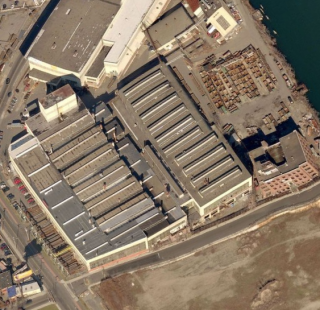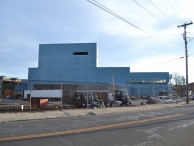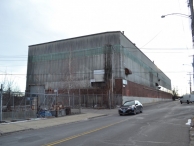Mill Record Bridgeport
RETURN TO ‘FIND MILLS’Disclaimer: Content for these properties was compiled in 2014-2017 from a variety of sources and is subject to change. Updates are occasionally made under Property Information, however the Connecticut Trust for Historic Preservation (dba Preservation Connecticut) makes no representation or warranty that the information is complete or up-to-date.
- Complex Name (Common)
- Bridgeport Brass Co., Plant #2
- Complex Name (Historic)
-
- Bridgeport Brass Co., Plant #2
- Address or Location
- 560 North Washington Avenue, Bridgeport
- County
- Fairfield
- Historic Designation
- Associated Mill Community
- n/a

- Historic Information
Companies Associated w/Complex
- Bridgeport Brass Co. #2 1937-1961
- Bridgeport Brass Co., div. National Distillers & Chemical Corp. 1961-1980
Use (Historic)
Largest Documented Workforce
5,800 (1941).
Historic Narrative
The Bridgeport Brass Co. was established in Bridgeport, Connecticut in 1865. The firm was organized by D.W. Kissam, Samuel R. Wilmot, and John Davol, the founders and managers of the Brooklyn, New York-based Wilmot and Kissam Manufacturing Co. These individuals relocated and reorganized the latter firm after being drawn to Bridgeport due to the city’s qualities as an industrial center and a new factory was soon erected at the corner of Main and Crescent Streets in East Bridgeport. Backed by $150,000 in capital, the Bridgeport Brass Co. was led by Davol as president, Wilmot as treasurer, and Kissam as secretary. At the time of its inception, the Bridgeport Brass Co. specialized in both the processing of brass and copper stock into wire, tubing, and sheeting, as well as the manufacture of finished brass and copper products. At the start the latter primarily consisted of kerosene burners and lamps, however, by the late-19th century a variety of goods were being manufactured. Such included clock movements, bicycle lanterns, and insulated copper wire. The company pioneered the manufacture of ‘hard drawn’ copper wiring, which resulted in an affordable product ideally suited for use in telephone, telegraph, and street railway applications. The success of these products resulted in significant growth for the business. During the mid-1880s the company’s plant occupied two acres and employed 300 hands. By the late 1890s, the factory complex had increased to five acres and 1,000 workers. The growth of the Bridgeport Brass Co. continued into the early 20th century and a plant on Housatonic Avenue – formerly occupied by the Union Brass Co. – was acquired by Bridgeport Brass during the early 1900s. The company dedicated this facility to the production of raw material, while work at the East Bridgeport plant largely centered on finished goods. Despite enduring significant setbacks as a result of the fallout of the Great Depression, the Bridgeport Brass Co. returned to profitability by the mid-1930s, and in 1937 began work on a significant expansion project to the north of the Housatonic Avenue plant. This included construction of a new rolling mill and combined office and manufacturing building. The added capacity aided the company’s efforts to support the Allied war machine during the Second World War, however, the demand for ever-increased production resulted in further additions during this period as well. The Bridgeport Brass Co. secured significant contracts from the United States Government during the Second World War, most notably for artillery shell production. The company’s work largely centered around the manufacture of naval 1.1-inch, army 37mm, and British two-pound shell casings, which the Bridgeport plant could turn out at a rate of 8,000,000 per month by October 1941. Employment peaked during the conflict and numbered some 5,800 hands in the firm’s Bridgeport factories in 1941. Although employment significantly declined in the post-war period, the company enjoyed records profits during the 1950s as both production capacity and efficiency increased. Much of this was made possible by the construction of a modern $5,000,000 rolling mill erected at the Housatonic Avenue plant in 1953. In 1961, the Bridgeport Brass Co. merged with the National Distillers and Chemical Corp. of New York, New York, a firm with extensive corporate holdings in the metals, chemical, and engineering fields. The Bridgeport company remained in operation as a division of National Distillers and retained its name and roughly 800 employees. By the mid-1970s, however, the combination of a period of recession, labor unrest, and competition from the plastics industry resulted in the closure of numerous Connecticut metalworking firms. The National Distillers and Chemical Corp. announced that closure of the Bridgeport plant was under consideration in 1977, and this plan was finally executed in 1980.
- Architectural Information
Number of Existing Buildings
Roughly eight (8) blocks.
Dates of Construction
1937, 1941, ca. 1942, 1953, ca. 1960, ca. 1975.
Architect
n/a
Builder
n/a
Building Type
Architectural Description
The former Bridgeport Brass Company plant is comprised of eight adjoining and freestanding primary blocks located on the east side of Housatonic and East Washington Avenues, north of Grand Street and south of East Washington Avenue’s intersection with Lindley Street. The oldest surviving portion of the sprawling mill complex consists of a three-story, 595’ x 336’ steel-frame rolling mill built at the northeast corner of the intersection of Housatonic Avenue and Grand Street in 1937. The building has a concrete foundation, red brick first-story apron walls, large expanses of steel-frame and glass walls on the upper stories, and a flat roof with 10’-tall clerestory monitors. The second- and third-story exterior walls have recently been sheathed with corrugated metal siding, thus obscuring the majority of the original window openings. A one-story ell links the 1937 building with a second rolling mill, this erected immediately south of the 1937 mill ca. 1942. The latter building is a three-story, 528’ x 158’ steel-frame block with a concrete foundation and first story, red brick apron walls, and large expanses of steel-frame and glass walls on the upper floors. The upper stories have been partially sided with corrugated metal sheathing, however, the majority of the window openings remain intact. The building has a flat roof topped by ten clerestory monitors. A four-story office and laboratory building stands immediately south of the ca. 1942 rolling mill. The office and laboratory was originally built in 1937, and then was expanded through the addition of a four-story ell on its south side in 1941. The building fronts on Grant Street and measures roughly 120’ x 150’, not including two one-story garages adjoining the north and south sides of its east elevations. Both phases of construction have steel frames, red brick apron walls with red brick stringcourses dividing each floor, large rectangular window openings with multipane steel sash, and a flat roof. The primary entrance to the building is accessed via a concrete bridge with concrete half walls leading from Grant Street to one-story brick and concrete entry pavilion. The entry consists of a wide opening flanked by fluted, quarter-round concrete pilasters topped by a concrete entablature. A four-story, 1,150’ x 160’ steel-frame rolling mill was erected roughly 500’ north of the 1937 rolling mill in 1953. The 1953 building has a concrete foundation, red brick first-story apron walls, a concrete stringcourse, alternating spans of translucent corrugated fiberglass and corrugated concrete panels on the upper stories, and a flat roof. The primary entrances to the building are located on the south elevation where there are several large bays with metal roll-up style doors. A four-story, 320’ x 80’ ell adjoins the building’s east elevation. This was likewise erected in 1953 and is of a similar design. The three final primary blocks of note associated with the plant are located immediately to the southeast of the 1953 rolling mill and northeast of the ca. 1942 rolling mill. These consist of a four-story, 70’ x 52’ boiler plant; a two-story, 124’ x 85’ manufacturing building; and a two-story, 124’ x 66’ warehouse. All of steel-frame construction with corrugated metal sheathing and they were erected ca. 1960, ca. 1960, and ca. 1975, respectively.
Exterior Material(s)
Structural System(s)
Roof Form
Roof Material
Power Source
Condition
Fair, Deteriorated
Condition Notes
The complex is in fair to deteriorated condition. Those portions of the plant that remain in use have been fairly well maintained, however, the southeast (ca. 1940) rolling mill and the office and laboratory building are deteriorated due to a lack of maintenance and exposure to the elements resultant of the loss of many of their windows. The entire section of the plant that once stood south of Grand Street has been demolished.
- Property Information
-
Specific Location
Thirteen parcels (560 North Washington Avenue #01, #02, #03, #04, #05, #06A, #06C, #06E, #06F, #06G, #06H, #07, & #08) totaling 5.95 acres located on the east side of Housatonic and East Washington Avenues, north of Grand Street and south of East Washington Avenue’s intersection with Lindley Street.
Adjacent To
Exterior Visible from Public Road?
Yes
Parcel ID / Assessor Record Link
- 47/ 1530/ 16/A 6A / Link →
- 47/1530/11/4 / Link →
- 47/1530/11/3 / Link →
- 47/1530/11/1 / Link →
- 47/1530/11/2 / Link →
Acreage
5.95
Use (Present)
- Sources
-
Form Completed By
Lucas A. Karmazinas
Date
01/22/2016
Bibliography
- List of Connecticut Manufacturers, 1922, 1924, 1930, 1932.
- Directory of Connecticut State Manufacturers, 1936, 1939.
- Industrial Directory of Connecticut, 1947.
- Register of War Production Facilities in Connecticut, 1951.
- Map of Fairfield County; Baker, William A., 1854.
- Atlas of the City of Bridgeport; J.B. Beers & Co., 1876.
- Atlas of the City and Town of Bridgeport; G.M. Hopkins & Co., 1888, 1917.
- Atlas of Bridgeport; Kershaw, William H., 1910.
- Sanborn Map Company, 1884, 1888, 1898, 1904, 1913, 1939, 1950.
- Aerial Survey of Connecticut, 1934, 1951, 1965, 1970, 1985.
- Bridgeport City Directory, Various editions.
- Hartford Courant, 1937, 1941, 1953, 1954, 1961, 1977.
- A History of the Old Town of Stratford and the City of Bridgeport; Orcutt, Samuel, 1886.
- History of Bridgeport and Vicinity; S.J. Clarke Publishing, 1917.
- Representative View(s)Click on image to view full file








